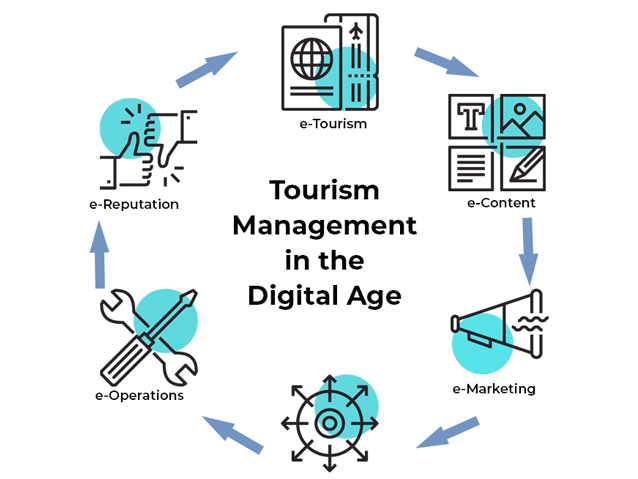Think of this bundle of courses, Tourism Management in the Digital Age, as a guided tour that takes you to a variety of destinations that are all part of an ongoing e-Tourism journey. It's a tour you come back to again and again, making small adjustments and improvements each time as the scenery and your fellow travellers change.
In other words, the e-Tourism Action Plan is:
Cyclical - like the seasons, one component flows into the next. There is no start and finish.
Iterative - as circumstances and conditions change, you implement small changes along the way, and they compound into bigger and bigger (hopefully positive!) outcomes as you loop through the plan.

The components
This Tourism Management in the Digital Age curriculum includes a full course of study for each component. It is suggested that you take the courses in the following order:
e-Tourism
As we have already discussed, e-Tourism is the analysis, design, implementation and application of IT and e-commerce solutions in the travel and tourism industry.
e-Content
Think of e-Content as ingredients. This is like the flour, oil and water with which to make a roti: you begin with best quality ingredients, and then you work to mix, roll, cook and serve.
The e-content ingredients we look at are:
- Name
- Logo
- Description
- Imagery
You'll mix the same ingredients as others do, but the addition of your unique filling and the way in which you serve it up are all parts of how you create, develop and manage your brand.
e-Marketing
e-Marketing, digital marketing, and internet marketing all share some overlap, but each also uses slightly different approaches. e-Marketing is much more relationship-oriented than Internet marketing, which in many cases is more of a one-way distribution of information. In the early days of the Internet, people simply put great big banner ads on websites in the same way as they would put advertising in newspapers and magazines.
Your e-marketing strategy is the process by which you target specific audiences through electronic means (social media, such as Facebook; websites; YouTube, etc) in order to get leads by building a relationship with them.
This relationship is measured by both reach and engagement.
Because almost all marketing you do online is measurable - you can easily find out how many people read your marketing, and how many clicked on your links, commented or shared your information - e-marketing is characterised by its iterative, re-inforcing nature: you quickly learn what works, and you do more of that.
e-Distribution
A distribution channel is a way that your services get to your customer, and how they pay for it. It can either be a direct transaction (for example, through your website), or involve third-party resellers.
Once you're using more than one channel - for example, your website plus both Booking.com and AirBnB - things can get really complicated really quickly.
e-Distribution is the catch-all title we use to refer to how you manage these distribution channels as well as your inventories and tariffs - how you ensure you’re not booking the same room to two different customers through two different bookings channels.
e-Operations
Hotel and guest house operations managers are in charge of the day-to-day operations: overseeing every aspect of housekeeping, catering and front office to ensure smooth operations and maximum profit.
Those traditional operations roles all still exist, but e-operations uses digital tools for efficiency and accuracy to reduce costs and increase profit by managing bookings, customers' bills, accounting and payments.
e-Reputation
Just as in your own personal life, you can work to enhance your reputation. If somebody is gossiping about you based on incorrect information, there are ways to correct their perspectives or those of their listeners.
In e-reputation, you work to manage perceptions about your brand and business by using online review tools to responding to criticisms and to broadcast the opinions of your fans as far and wide as possible.